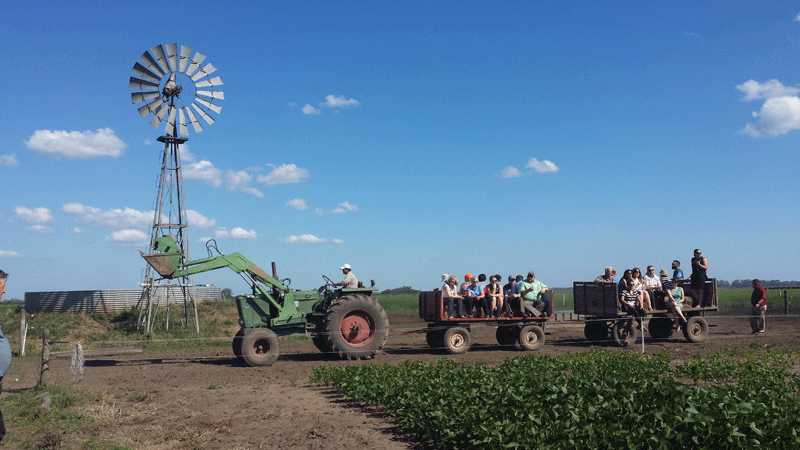A leadership experience
STUDY TOUR OF CHILE AND ARGENTINA
Tom Farfaras, Grain Farmers of Ontario’s finance manager, was a member of Class 15 of the Advanced Agricultural Leadership Program (AALP). At their graduation ceremony at the end of March, Farfaras was selected by his class peers as someone who exemplifies qualities demonstrated by the late Richard Lichty (Class 6) — passion for rural communities and agriculture and faith in the ability of people to make a difference — and was presented with the Richard Lichty Memorial Award. One of the final learning experiences for the group was an International Study Tour to Chile and Argentina. Farfaras shares his personal account of their journey.
OUR STUDY TOUR began in Chile, a Spanish speaking progressive and vibrant country of 18 million people whose narrow 350 kilometre wide and 4,300 kilometres long geography provides a diverse climate and conditions to support a wide variety of agricultural activity and production. Livestock, field crops, and forestry operations are primarily located in the southern cooler regions with fishery operations located on the pacific coast. Fruit, vegetable, and table grape production occurs in the central valley region surrounding Santiago which takes advantage of a Mediterranean climate with access to irrigation from the surrounding Andes Mountains. The wine grape growing regions are spread throughout the country with many vineyards concentrated in central Chile. Tree nuts, such as almonds and walnuts, could be seen in the hills as we drove into Santiago from the airport.

CHILE
The capital city is home to more than 6.3 million people. Its importance and economic growth are evidenced by several newer buildings with impressive architecture that are engineered to withstand the earthquakes which occur frequently in the country. One recurring feature that stood out was the newer office buildings which feature terraces lined with trees and windows that open to the outdoors.
While in Santiago, we visited the Canadian Embassy, a Canadian Chartered bank, a non- profit organization that promotes innovation and industrial growth, a major newspaper, a charitable facility operated for poor and socially outcast seniors, and the main wholesale market for fresh fruits and vegetables.
Outside of Santiago we toured a dairy farm operation with 1,200 head. That seems large by Ontario standards, but I would soon learn that didn’t equal larger milk production. The thinner livestock produce a lower volume of milk per head than you would get from an Ontario dairy cow. On the farm, I noticed a simple open infrastructure, consisting of just a roof over a concrete floor, which is used to shelter the herd. I learned that housing the animals is just one of the challenges of operating this type of farm in a warmer climate.
The aging farm owner told our group that the scale of his operation has grown over time and he has good farm managers and staff that assist in his operation. He was humble and shared that he has made mistakes along the way, such as pouring the incorrect slope on concrete stalls. He also shared that his son, educated as an engineer and working away from the farm during the week, is learning about the farm operation and spends Saturdays with him on the farm in preparation for taking over the operation.
This farmer is always looking to improve his operation. On the property you could see workers temporarily piling and covering grain on hills as preparations were underway for the construction of a storage facility for feed.
SUCCESS AND FAILURE
From Santiago we travelled 87 kilometres south to Rancagua where we spent the next three days touring a seed processing plant, fruit orchards of cherries, apples, pears, plums, kiwis, and nectarines, an agricultural vocational school teaching irrigation technology, and a winery.
One orchard farmer, Martin, returned to Chile after studying in New Zealand back in the 1980’s. Holding a stick, he illustrated in the soil how over time he amassed the land base for his orchard operation. Prior to his arrival, land had been seized from the original owners by the government, divided into smaller plots and given to small farmers, but they lacked the skills, knowledge, and capital to sustain the operations. Over time he was able to acquire the surrounding land from them.
Martin says he is fortunate to have a good farm manager and staff. He shared that Chile’s employment regulations mandate long termination pay periods of one year, have high minimum wages, and set the minimum working age at 18 years. His philosophy is to treat people fairly and he is investing in his employees to ensure they have training to be more productive and effective in picking fruit. He emphasized the example of accommodating expectant mothers during harvest to ensure they will return to work after their babies are born.
Martin was asked about a sign that is posted in the orchard with the words ‘Never Forget’. He shared how he failed trying to introduce kiwi to the area and nearly lost his farm. He had researched, planted, and convinced several other farmers to also grow kiwi. Little did he know that just as the first harvest was approaching, the crop would fail due to disease. It was later learned that the disease originated in the soil, but there had been nothing to warn him of this potential problem. He had to take on a loan to pay for all the failed stock that was being ripped out.
After all the success he had, he was humbled that in his older years he almost lost his farm and that he had contributed to the financial loss of his fellow farmers who also tried to grow this kiwi. He took ownership of the failure and said that his relationships with the other farmers are intact, but it was not the best period in his life.
WATER RESOURCES
As we continued our travels through Rancagua, I learned irrigation practices are managed by the local water authorities. However, there is acknowledgement that a coordinated effort is needed to fund and construct reservoirs to capture water from the snowmelt that originates from the Andes during the summer months of December through February and from the winter rain season from June to August. The management of water resources also includes restrictions on the drilling of new wells. Farmers typically have to drill deeper through existing wells.
Although the key economic driver is copper mining located in Rancagua and the desert regions to the north, Chile has numerous free-trade agreements to support and promote its agriculture products abroad. I felt this was progressive. One example is a USDA supervised inspection facility located close to Rancagua that inspects samples of fruit and vegetables prior to being loaded and shipped on containers to U.S. destinations on the west and east coasts.
ARGENTINA
The second leg of our trip was to Argentina and as we flew to Buenos Aires and crossed the Andes, I thought that Chile and Argentina would have many things in common. I expected that with both countries having democratically elected women leaders as presidents, predominately Spanish speaking citizens, and a common border there would be few differences. I was wrong.
Prior to the tour, I recall reading that Argentina defaulted on its sovereign debt in late 2014. The Argentinian government closed agricultural trade in order to keep its domestic commodity prices low. They have maintained export tariffs on agricultural commodities, but when confronted with the combination of lower grain and oilseed prices and inflation fears, many farmers are unwilling to sell. They don’t want to subsidize government revenues and expressed plans to store and hold onto their grains. It appears this issue is being used politically to create an urban/rural divide. It is unlikely that the situation will improve even with an upcoming election later this year.
GRAIN FARMERS
As we drove 220 kilometres to Pergamino from Buenos Aires, we passed by field after field of corn and soybeans. We toured one family farm operation, headed by a man named Alejandro, that produces corn, soybeans, and wheat using no-till and also runs a full-cycle cattle operation. The farm provides custom farming as most farmers in this region don’t own large equipment. The farm equipment is stored centrally in a nearby town to service the farms and to simplify equipment maintenance and service. Alejandro stores and conditions the grain in the town and transports it using his own trucks 160 kilometres to the Parana River terminals near Rosario. Alejandro spoke of his desire to invest in new equipment but said that the economic conditions were not favourable for him to do this at this time.
The next day we travelled to Santa Isabel where we were hosted by a family with three generations living on the farm. They have diversified in order to keep the farm in the family. Inheritance laws in Argentina require land to be divided equally, so over time, farms have become smaller. This family grows corn, soybeans, and wheat and has a Hampshire Down sheep stud and a poultry operation. They also host group receptions such as weddings and tours.
AGRICULTURAL SCHOOL
One of the highlights in Argentina was a tour of a private agricultural school in Venado Tuerto for children in kindergarten to high school. This is a full operating farm where students learn and practice farming techniques and eat the food they produce. They attend classes and over the course of their education they learn science and theory and apply this to the farm operation. They learn about soil, fertilizer, crops, and livestock production (dairy, poultry, pig, cattle) and learn to operate all machinery. It is a great model.
Overall from the study tour, I learned that there were several common issues and challenges that I could relate to regardless of the geography — succession plans, rural populations migrating to cities, public perception of farming and agriculture, diversity and scale of farm operations, access to financing, research and development, education, social and charitable programs, regulations, resources, weather, infrastructure, government policies. Most important, I learned farmers around the world share a sense of modesty, hope, and passion for the life lived in agriculture. •






















